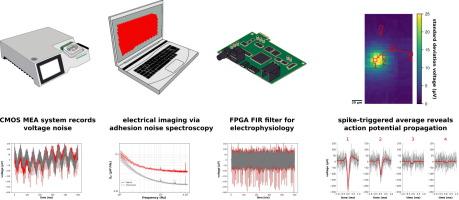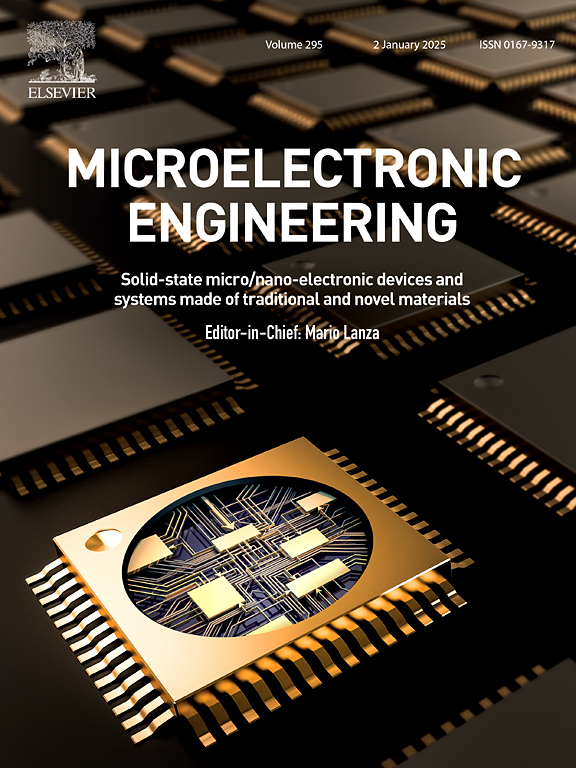基于高密度cmos微电极阵列的亚细胞分辨率电生理FPGA数字滤波
IF 3.1
4区 工程技术
Q2 ENGINEERING, ELECTRICAL & ELECTRONIC
引用次数: 0
摘要
基于cmos的微电极阵列(MEAs)可以在高时空分辨率下记录微米级细胞结构的神经组织电活动。然而,连续记录细胞外电压会产生空间和时间信息非常稀疏的大型数据集。为了实现有效的策略,我们提出了一种现场可编程门阵列(FPGA),它可以过滤在28 kHz采样的连续CMOS MEA数据流并提取电生理相关信息。首先,通过粘附噪声光谱对神经组织覆盖的传感器进行无标签识别,选择感兴趣的传感器。通过光学显微图像验证了基于粘附噪声的电成像。FPGA有限脉冲响应(FIR)滤波数据与基于软件的后处理数据进行了验证。在第二步中,我们实现了一个峰值触发平均(STA)算法,以亚细胞分辨率识别和可视化视网膜神经元的电活动,从而可以跟踪神经组织内轴突信号的传播。这种无标签、无创的方法可以定位感兴趣的传感器,进行电生理记录和提取神经元信号。它代表了神经科学工具的重大进步,有助于以前所未有的时空分辨率研究神经网络动力学。本文章由计算机程序翻译,如有差异,请以英文原文为准。

Digital filter on FPGA for subcellular resolution electrophysiology using a high-density CMOS-based microelectrode array
CMOS-based microelectrode arrays (MEAs) are used to record the electrical activity in neural tissues down to micron-scale cellular structures at high spatiotemporal resolution. Continuous recording of extracellular voltages would, however generate large datasets with very sparse spatial and temporal information. Towards an efficient strategy, we propose here a Field Programmable Gate Array (FPGA) which filters the continuous CMOS MEA data stream sampled at 28 kHz and extracts electrophysiological relevant information.
In a first step, sensors of interest are selected based on the electrical label-free identification of those sensors covered by the neural tissue via adhesion noise spectroscopy. The adhesion noise-based electrical imaging is validated against light microscopic images. The FPGA finite impulse response (FIR)-filtered data is validated against software-based post-processed data.
In a second step, we implement a spike-triggered average (STA) algorithm to identify and visualize electrical activity at subcellular resolution in retinal neurons, which allows for the tracking of axonal signal propagation within the neural tissue.
This label-free, non-invasive method enables the localization of sensors of interest for electrophysiological recordings and the extraction of neuronal signals. It represents a significant advancement in neuroscience tools, which facilitates the study of neuronal network dynamics at unprecedented spatiotemporal resolution.
求助全文
通过发布文献求助,成功后即可免费获取论文全文。
去求助
来源期刊

Microelectronic Engineering
工程技术-工程:电子与电气
CiteScore
5.30
自引率
4.30%
发文量
131
审稿时长
29 days
期刊介绍:
Microelectronic Engineering is the premier nanoprocessing, and nanotechnology journal focusing on fabrication of electronic, photonic, bioelectronic, electromechanic and fluidic devices and systems, and their applications in the broad areas of electronics, photonics, energy, life sciences, and environment. It covers also the expanding interdisciplinary field of "more than Moore" and "beyond Moore" integrated nanoelectronics / photonics and micro-/nano-/bio-systems. Through its unique mixture of peer-reviewed articles, reviews, accelerated publications, short and Technical notes, and the latest research news on key developments, Microelectronic Engineering provides comprehensive coverage of this exciting, interdisciplinary and dynamic new field for researchers in academia and professionals in industry.
 求助内容:
求助内容: 应助结果提醒方式:
应助结果提醒方式:


